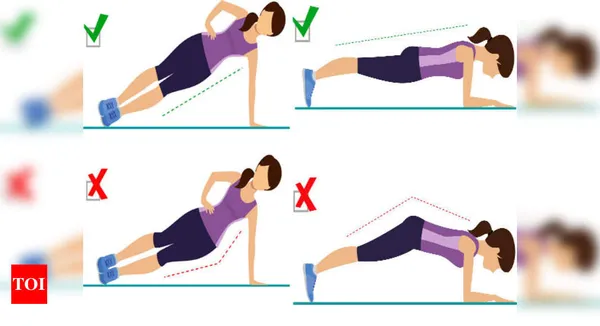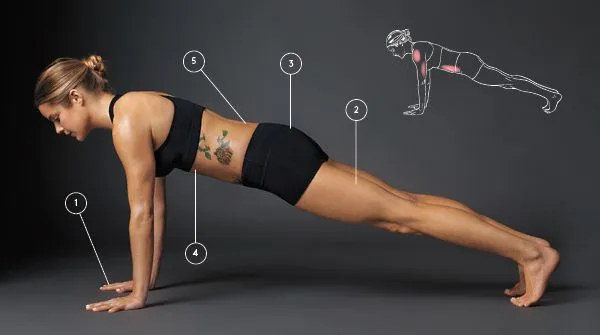Table of Contents
Welcome to Kizworld, your ultimate guide to fitness and well-being. In this comprehensive guide, we will delve into the world of planks, exploring the proper technique, variations, tips, and common mistakes to avoid. Whether you are a beginner or an experienced fitness enthusiast, learning How to do a plank correctly is essential for maximizing its benefits and avoiding potential injuries. So, get ready to engage your core, improve your posture, and reduce your risk of back pain with our tips on how to do a plank.
How to do a Plank: The Ultimate Core-Strengthening Exercise
I. How to Do a Plank: A Step-by-Step Guide
How to Do a Plank: A Step-by-Step Guide
1. Starting Position
Begin by lying face down on the floor with your legs extended and your feet together. Place your forearms on the floor, shoulder-width apart, with your elbows aligned below your shoulders. Your body should form a straight line from your head to your heels.
- Keep your back flat and your core engaged.
- Press your toes into the floor to activate your legs.
- Look straight down at the floor, keeping your neck in line with your spine.
2. Hold the Plank
Once you're in the starting position, hold the plank for as long as you can, maintaining proper form. Aim to hold the plank for at least 30 seconds, gradually increasing the duration as you get stronger.
- Focus on breathing deeply and evenly throughout the exercise.
- Keep your body in a straight line, avoiding arching your back or sagging your hips.
- If you feel pain or discomfort, stop the exercise and consult a healthcare professional.
3. Release the Plank
To release the plank, slowly lower your body back to the floor, one vertebra at a time. Keep your core engaged and avoid collapsing your spine. Once you're back on the floor, rest for a few seconds before repeating the exercise.
- Start with a few sets of 3-5 repetitions, gradually increasing the number of sets and repetitions as you progress.
- Incorporate the plank into your regular workout routine, aiming to perform it 2-3 times per week.
- As you get stronger, challenge yourself by trying different variations of the plank, such as the side plank, the reverse plank, or the high plank.
The Best Gymnastics Exercises for Core StrengthHow to Master the Basic Gymnastics Skills
II. Benefits of Doing a Plank
Benefits of Doing a Plank
The plank is a static exercise that engages your core, strengthens your upper and lower body, and improves your posture. Here are some key benefits of doing plank:
Benefit | Description |
|---|---|
Core Strength | The plank targets your abdominal and back muscles, helping to stabilize your spine and improve your balance. |
Improved Posture | Holding the plank position helps align your spine and reduce slouching, leading to better posture. |
Shoulder and Arm Strength | The plank also works your shoulders, arms, and triceps, helping to build upper body strength. |
Increased Flexibility | Regularly doing the plank can improve your flexibility and range of motion in your spine, hips, and shoulders. |
Reduced Risk of Back Pain | Strengthening your core muscles with the plank can help prevent back pain and injuries. |
Enhanced Athletic Performance | The plank is a foundational exercise for athletes as it improves overall strength, stability, and balance, which are essential for various sports. |
Incorporate the plank into your workout routine to reap these benefits and enhance your overall fitness.
Learn how to do a plank correctly and effectively.
III. How to Do a Plank
To perform a plank correctly:
- Start on your forearms and knees, with your hands shoulder-width apart and your knees hip-width apart.
- Step your feet back one at a time until your body forms a straight line from head to heels.
- Hold this position, engaging your core and keeping your back flat. Your shoulders should be directly over your elbows.
- Hold the plank for as long as you can, maintaining proper form. Aim for 30 seconds to a minute for beginners and gradually increase the duration as you get stronger.
- To exit the plank, bend your knees and bring your feet back to the starting position.
As you progress, you can try variations of the plank to challenge your body and target different muscle groups. Some variations include:
- Side plank: Works your obliques and helps improve your balance.
- High plank: Requires more upper body strength and engages your shoulders, triceps, and chest.
- Elbow plank: Focuses on your forearms, biceps, and shoulders.
- Single-leg plank: Challenges your balance and core stability.
The plank is a versatile exercise that can be easily incorporated into your home or gym workout routine. It is a great way to strengthen your core, improve your posture, and enhance your overall fitness.
IV. Common Mistakes to Avoid When Doing a Plank
Common Mistakes to Avoid When Doing a Plank
To achieve the full benefits of a plank and prevent potential injuries, it's important to avoid these common mistakes:
- Sagging Hips: Keep your hips lifted and in line with your shoulders. Avoid letting them drop or arch your back.
- Flexing Feet: Press your toes into the ground to engage your core and prevent your feet from bending.
- Rounding Back: Maintain a flat back throughout the exercise. Avoid arching your back or pushing your head forward.
- Looking Up: Keep your gaze focused on the ground. Tilting your head back or looking up can strain your neck.
- Holding Your Breath: Remember to breathe naturally throughout the entire duration of the plank. Avoid holding your breath as it can cause dizziness or discomfort.
For more plank variations, check out our article on Best Gymnastic Exercises for Core Strength.
Looking for alternatives to the plank? Read our article on Best Calisthenics Exercises.
For more information related to healthy exercises, visit our website Kizworld.
V. Variations of the Plank
Variations of the Plank
The plank is a versatile exercise that can be modified to target different muscle groups and challenge your core in various ways. Here are some popular variations of the plank:
- Side Plank: This variation targets the obliques and helps improve balance and stability. To perform a side plank, lie on your side with your legs extended and your feet stacked on top of each other. Prop yourself up on your elbow and raise your hips until your body forms a straight line from head to heels. Hold the position for 30 seconds to a minute.
- Reverse Plank: This variation focuses on the hamstrings, glutes, and lower back. Start by sitting on the floor with your legs extended and your hands behind you. Press your palms into the floor and lift your hips until your body forms a straight line from head to heels. Hold the position for 30 seconds to a minute.
- High Plank: This variation is similar to the traditional plank, but your hands are placed on an elevated surface, such as a bench or chair. This increases the intensity of the exercise and engages the shoulders and triceps more.
- Low Plank: This variation is the opposite of the high plank, with your hands placed on the floor and your hips slightly raised. This variation targets the lower abs and obliques.
- Plank with Leg Lift: This variation adds a dynamic element to the plank by lifting one leg off the ground and holding it for a few seconds before returning it to the starting position. This engages the core and improves balance.
- Plank with Arm Lift: Similar to the plank with leg lift, this variation involves lifting one arm off the ground and holding it for a few seconds before returning it to the starting position. This targets the shoulders, triceps, and core.
These are just a few examples of the many variations of the plank exercise. By incorporating different variations into your workout routine, you can challenge your muscles in new ways and keep your core strong and engaged.
If you are new to the plank exercise, start with the traditional plank and hold it for as long as you can. As you get stronger, you can try the different variations and gradually increase the duration of each hold. Remember to maintain proper form throughout the exercise to avoid injury.
Here are some additional tips for performing the plank exercise effectively:
- Keep your back straight and your core engaged throughout the exercise.
- Press your heels into the floor to activate your hamstrings and glutes.
- Don't let your hips sag or arch your back.
- Breathe deeply and focus on maintaining the position.
- Start with shorter holds and gradually increase the duration as you get stronger.
The plank is a challenging but rewarding exercise that can help you build a strong core, improve your posture, and reduce your risk of back pain. By incorporating different variations into your workout routine, you can keep your core engaged and challenged in new ways.
If you have any questions or concerns about performing the plank exercise, be sure to consult with a qualified fitness professional.
Related posts: How to Do a Handstand, The Benefits of Gymnastics for Kids, The Best Gymnastics Equipment for Home Use
VI. Conclusion
The plank is a versatile and effective exercise that can be easily incorporated into any fitness routine. Whether you are looking to improve your core strength, posture, or overall fitness, the plank is an excellent choice. By following the proper technique, variations, and tips discussed in this guide, you can maximize the benefits of this exercise while minimizing the risk of injury. Remember to start slowly and gradually increase the duration of your planks as you progress. If you have any underlying health conditions or experience pain during the exercise, it is advisable to consult with a healthcare professional before performing planks. With dedication and consistency, the plank can help you achieve your fitness goals and improve your overall well-being.